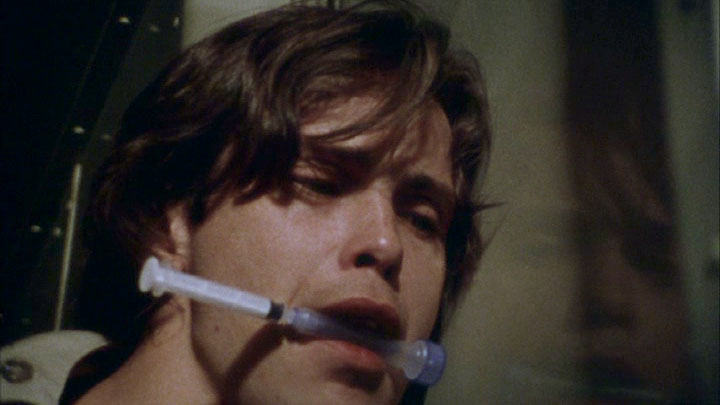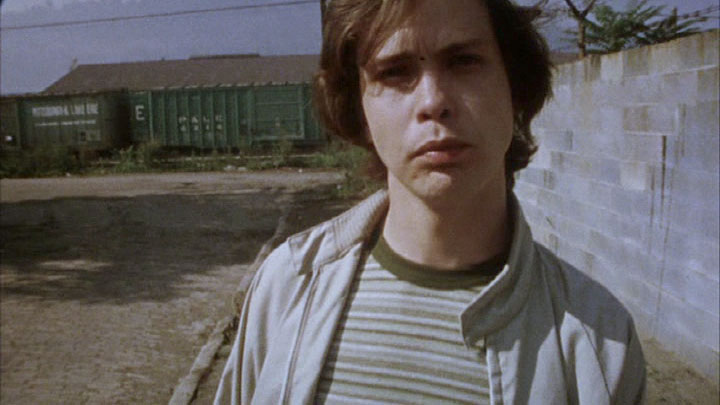(article originally appeared on Mark Deniz’s
“Vampire Appreciation Month” site
as “George Romero’s Martin: Portrait Of An Honest Vampire”)
My first exposure to George A. Romero’s Martin (1977) came via an event at the Academy Of Motion Pictures Arts & Sciences. George had been selected to give a George Pal Lecture, the Academy’s special night in which a cinematic luminary is invited to give an address on the state of fantasy/sci-fi/horror. I don’t remember a lot about that evening. I do remember being introduced to George Romero – and Adrienne Barbeau – by Bill Moseley (Bill’s intro to George was when he played brother Johnnie in Tom Savini’s 1990 Night Of The Living Dead remake). I also remember George Romero saying, in his address, how much he was influenced by Powell & Pressburger’s The Tales Of Hoffmann (1951) and repeatedly rented out a 16mm print of the film when he was a kid in NYC – except sometimes the print wasn’t available because it was being rented by another local kid named Martin Scorsese.
The one thing I most vividly recall from the evening was the clip George showed from a movie of his called Martin, a movie completely unknown to me at the time. It was the scene in which the title character – the vampire Martin – stalks a married female victim in her home and must deal with her and the unexpected arrival of her lover.
My mind was blown.

We see the traditional vampiric poses so often, they barely have any symbolic impact anymore, much less emotional or visceral impact. Onscreen, feeding on human blood has the same impact as a death by gunshot – a storytelling trope which ticks an intellectual “shocking” box in our minds without communicating any real impact or real human experience.
Martin feeds by first injecting his victims with a hypodermic, then once the victim is unconscious, opens them up with a razor blade to feed on the blood. The procedure is performed with the skill and adrenaline agitation of a hunting forest predator – with nothing romantic or sublime about it. It is at once both mechanical and savage, idiotic and fiendish.
The chaos, the madness, of the clip Romero showed us was breathtaking. The maniac bloodsucker darting around the house, wielding a hypo, alternately evading and wrestling the woman’s half-naked lover in a farce from Hell – it was absurd, and very, very real – and very frightening.
There are few movies I can think to compare Martin with. It’s as if Harmony Korine had made a vampire movie produced by David Cronenberg. Romero goes to every conceivable length to make his extraordinary vampire creation as banal and mundane as possible. He’s an unromantic 84 years old. He dresses like someone with Asperger’s. He is an unappealing, creepy person, setting aside his vampire characteristics. He lives in a miserably ordinary house with a miserably ordinary family. His vampirism seems quite normal, while the hocus pocus of religion or concepts of Good and Evil seem like the outlandish superstitions.
 Martin has that riveting knife-edge freshness and immediacy that has been virtually absent from filmmaking for 20 years. Watching it, you have the unnerving sense that the storyteller is not playing by your rules, that you’ve ventured into an arena entirely unpredictable and your safety may not be the storyteller’s highest priority. The 70’s cinema – hands down the best decade for horror – completely embraced these twists and turns and breathtaking shocks, the things that can burn a film into your mind for a lifetime. Martin, The Texas Chainsaw Massacre (1974), The Exorcist (1973), Halloween (1978) – on and on – aren’t masterpieces because of their “spooky” subject matter. The very way they are told, their rhythms, structures, and turning points are calculated to give the audience a transformative experience. They are not about giving the audience what it wants, but giving it what it needs.
Martin has that riveting knife-edge freshness and immediacy that has been virtually absent from filmmaking for 20 years. Watching it, you have the unnerving sense that the storyteller is not playing by your rules, that you’ve ventured into an arena entirely unpredictable and your safety may not be the storyteller’s highest priority. The 70’s cinema – hands down the best decade for horror – completely embraced these twists and turns and breathtaking shocks, the things that can burn a film into your mind for a lifetime. Martin, The Texas Chainsaw Massacre (1974), The Exorcist (1973), Halloween (1978) – on and on – aren’t masterpieces because of their “spooky” subject matter. The very way they are told, their rhythms, structures, and turning points are calculated to give the audience a transformative experience. They are not about giving the audience what it wants, but giving it what it needs.
In today’s motion picture vampires we see beautiful merchandise, beautifully packaged and factory sealed for freshness. But there is little that is truly shocking and transcendent. Rather than the bloodsucker being a pernicious monstrosity with a story that, if studied, might make us wise, we prefer evil with a candy face, easily digestible horrors, monsters as harmless as we fantasise we are.
Martin, though a killer and a monster, is the one character who consistently tells the truth in Romero’s film. Give us back our truth-telling vampires.

